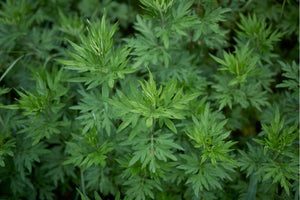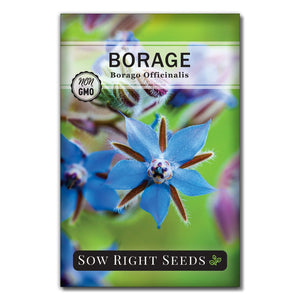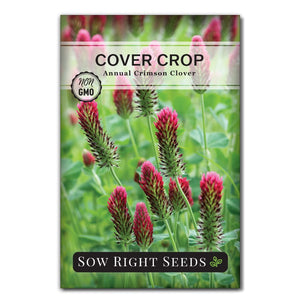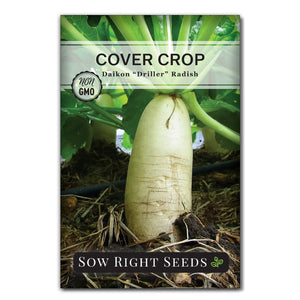2 Easy Ways to Amend and Improve Clay Soil - Plus 1 to Avoid
Improving soilIs your soil sticking to your shoes? Is water sitting on top and not draining through? It could be that you have clay soil. But that doesn't mean the end of your gardening dreams.
With these easy ways to amend your soil and knowing what to avoid, you can create fertile soil that’s just right for your garden.

What is Clay Soil?
Heavy clay soil is excellent for making pottery! It’s smooth, holds lots of water, and can be shaped into usable objects. But clay soil is not ideal when you’re trying to grow vegetables. Sure, you want your soil to hold water, but not in a way that smoothers roots. And although you want small particles for growing root vegetables, the ultra-fine clay particles are too smooth and don’t allow air pockets.
The ideal garden soil
To know why gardeners complain about clay soil, it’s important to understand what creates the ideal garden soil. Healthy, loamy soil will have a mix of inorganic materials, air, water, and organic materials. Organic material is a crucial part of healthy soil but isn’t the largest component. Clay, silt, and sand are found in larger quantities. So clay in your garden soil only becomes problematic when there is too much clay in proportion to the other components.
Why clay soil is tough for growing
Plants don’t grow well in clay because it's hard, compacted soil that’s often too acidic, holds too much water, and not enough oxygen.
The particles in clay are so fine that the soil holds onto water and doesn’t allow oxygen for roots. Without oxygen, the water is inaccessible to roots, and they will be smothered. In addition, the microorganisms can’t grow in the soil with too much water and no air.
What amendments will improve clay soil?
You need to add two things to improve clay soil: oxygen and organic material.
So how do you add organic material and air to the soil? Well, it’s easier than you think.
-
Start growing - This may seem counterintuitive since you want to create good soil to grow plants. But good soil needs microorganisms. Growing plants that put down roots is the best way to get started. The root systems will also begin to aerate the soil. Cover crops are an excellent way to add both air and organic material to the ground.
- Add layers - Digging down can make your clay soil light and fluffy - for a while. But after a heavy rain, clay soil will absorb the moisture and return to its previous hard compacted state. However, adding layers of organic matter on top of your clay soil will create an environment where microorganisms can thrive. These will add oxygen to your soil. We’ll explain more about how these things will improve your soil.
Organic Matter
Organic matter is the best thing you can add to clay soil. This is crucial for turning heavy clay into loamy fertile garden soil.
Organic matter is anything from nature, and it should be partially broken down. You can start with what you have. Use your compost, ground-up leaves, wood chips, and aged manure. All of these will help. Add 2 or 3 inches on top of your soil.
Fall is a great time to add organic material to your garden. Over the winter, these will break down and contribute microorganisms to the soil.

Cover Crops
Planting something in clay soil is a great way to start improving the soil, and cover crops are excellent. They will begin the growing process, introducing good bacteria and organic matter and building better soil. Daikon driller radish is one of the best cover crops for breaking up clay soil. You can read more about Daikon Radish on our blog. Any cover crop can be a start for changing the makeup of your soil. You can plant cover crops in the fall and early spring or any time you don't have another crop growing.
Worms
Worms are great at breaking up the soil. However, you can’t just dump some worms on your clay soil. You first need to create an environment where worms and microorganisms can thrive. Earthworms are higher on the food chain and need something to eat. Putting down a layer of compost and ground-up leaves with the earthworms will give them a viable layer to start working with.
Gypsum
Even though gypsum can help break up clay soil, it adds calcium sulfate. So do a soil test first. You may not want to use this method if your soil already has enough calcium.
What you should NEVER add to clay soil
Never add sand to clay soil. While it seems like this would break it up and give it more texture, more likely you’ll just create cement. (Think adobe bricks and mud huts!)
Why adding sand doesn’t improve clay soil
Sand doesn’t have nutrients. If you add sand, you’re just adding more inorganic material. While it is adding larger particles, those particles aren’t contributing to what the soil really needs, which is a healthy microbiome.
How to make the best of clay soil
Remember that it will take time to improve clay soil. However, as you continue to improve your clay soil, you don’t have to wait around and not plant anything. There are ways to make the best of clay soil while you work to improve it.
- Grow plants that do well in clay. There are natural grasses and wildflowers that grow just fine in clay soil. Adding these to your garden will improve the view and your soil.
- Water less frequently and slowly so that the water has time to soak in deeply. Then allow the ground to dry out enough for plant roots to take up water and get oxygen.
- Use walkways. Don’t keep compacting the ground by walking on it. Instead, design your garden space so you can walk around areas where you are improving the soil.
- Use a broad fork to add air pockets. While this is only a temporary fix, it can allow you to plant in the pockets created.
- Plant Daikon radish. This excellent cover crop grows deep roots and will aerate the soil. You can pull them out or let the roots rot in the ground to add more organic material to your garden soil.
- Always cover the soil. Add layers of organic mulch whenever you can.
- Don’t till clay soil when it’s wet. (Unless you’re trying to make pottery.) Try no-till gardening methods.
- Add layers. Sheet composting, or “lasagna gardening,” is a method that can improve clay garden soil over time.
- If you want a quick fix, you can always put a raised garden bed over clay soil.
Plants to Grow in Clay Soil
One way to make the most of your clay soil is to grow plants that don't mind clay soil. There are many wildflowers and vegetables that grow just fine in clay soil.
Flowers you can grow in clay soil
These flowers don't seem to mind the less-than-ideal growing conditions in clay soil.
Vegetables you can grow in clay soil
Choose vegetables that like soil that is consistently wet. If your clay soil can drain enough, you can plant vegetables with shallow roots.
When you have clay soil, the best way to improve and amend your soil is to start with what you have. First, try growing cover crops and other plants that can tolerate poor soil. Then continue to add organic matter to the top layers. Over time this will break down and create better soil.
And remember, don't add sand to clay soil unless you are trying to make bricks!
Don't give up your gardening dreams. Try planting these clay-tolerant plants and cover crops. Take action now to improve your garden soil.











Leave a comment